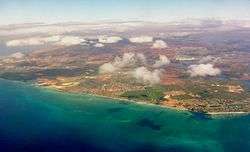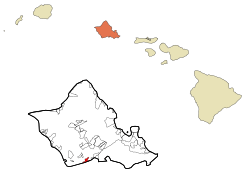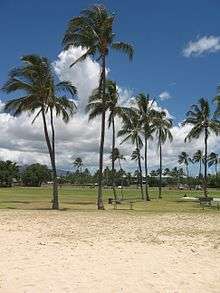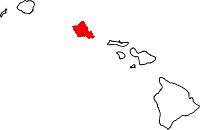ʻEwa Beach, Hawaii
ʻEwa Beach (/ɛvə/)[1] or simply ʻEwa is a census-designated place (CDP) located in ʻEwa District and the City & County of Honolulu along the leeward coast of Oʻahu in Hawaii. As of the 2010 Census, the CDP had a total population of 14,955. The U.S. postal code for ʻEwa Beach is 96706.
ʻEwa Beach ʻEwa | |
|---|---|
 Aerial photo of the ʻEwa Beach area of Oʻahu | |
 Location in Honolulu County and the state of Hawaiʻi | |
| Coordinates: 21°18′56″N 158°0′26″W | |
| Country | |
| State | |
| County | |
| Area | |
| • Total | 1.9 sq mi (4.8 km2) |
| • Land | 1.4 sq mi (3.6 km2) |
| • Water | 0.5 sq mi (1.2 km2) |
| Elevation | 10 ft (3 m) |
| Population (2010) | |
| • Total | 14,955 |
| • Density | 10,682.1/sq mi (4,172.7/km2) |
| Time zone | UTC-10 (Hawaii-Aleutian) |
| ZIP code | 96706 |
| Area code(s) | 808 |
| FIPS code | 15-07450 |
| GNIS feature ID | 0358767 |

History and etymology
The word ʻewa means "crooked" or "ill-fitting" in Hawaiian.[2] The name comes from the myth that the gods Kāne and Kanaloa threw a stone to determine the boundaries, but it was lost and later found at Pili o Kahe.[3] Hawaiian settlement on the ʻEwa Plain dates back at least to the 12th Century C.E., at which time Kanaka maoli expanded the main channel of Puʻuloa (Pearl Harbor) before creating fishponds and terraced agricultural fields in the surrounding area. Scholars have recognized ʻEwa's ancient fishponds as exemplary evidence of Native Hawaiian ingenuity.[4]
Before Ewa Beach became a town it was first a huge plantation farm. With 11,000 acres (4,500 ha) of land sublet by Benjamin Dillingham, W.R. Lowrie became the first plantation manager in 1891, when Hawaiʻi was under the rule of Queen Liliʻuokalani.[5] Ewa Beach is significant for its association with Ewa Sugar Plantation. Throughout the twentieth century, it played a very influential role in Hawaii's culture, economy, and politics.[6]
Along much of the South Shore of Oʻahu, ʻEwa is a reference to the direction of ʻEwa Beach, roughly westwards along the shore. Related terms are "mauka" (towards the mountains, roughly northwards), "makai" (towards the ocean, roughly South), and Diamond Head or Koko Head, roughly eastwards along the shore.
Geography
ʻEwa Beach is located at 21°18'56" North, 158°0'26" West.[7] The main thoroughfare is Fort Weaver Road (State Rte. 76) which runs north (away from the coast) past ʻEwa to Waipahu, connecting there to Farrington Highway (State Rte. 90) and the H-1 freeway.
According to the United States Census Bureau, the CDP has a total area of 1.9 square miles (4.9 km2), of which 1.4 square miles (3.6 km2) is land and 0.4 square miles (1.0 km2) is water. The total area is 24.06% water, consisting entirely of the Pacific Ocean off the island shore.
The ʻEwa Beach CDP does not include Ocean Pointe, ʻEwa Gentry, Iroquois Point, or ʻEwa Villages, though these are included within the postal service's ZIP code for the area.[8][9]
Climate
| Climate data for Ewa Beach | |||||||||||||
|---|---|---|---|---|---|---|---|---|---|---|---|---|---|
| Month | Jan | Feb | Mar | Apr | May | Jun | Jul | Aug | Sep | Oct | Nov | Dec | Year |
| Average high °F (°C) | 80.5 (26.9) |
80.6 (27.0) |
81.4 (27.4) |
83.0 (28.3) |
84.4 (29.1) |
86.6 (30.3) |
87.6 (30.9) |
88.3 (31.3) |
88.3 (31.3) |
86.7 (30.4) |
84.2 (29.0) |
81.6 (27.6) |
84.4 (29.1) |
| Average low °F (°C) | 63.2 (17.3) |
62.7 (17.1) |
64.4 (18.0) |
66.2 (19.0) |
67.4 (19.7) |
69.8 (21.0) |
71.1 (21.7) |
71.4 (21.9) |
70.4 (21.3) |
69.6 (20.9) |
67.9 (19.9) |
65.3 (18.5) |
67.4 (19.7) |
| Average precipitation inches (mm) | 3.1 (79) |
2.2 (56) |
2.2 (56) |
1.2 (30) |
1.0 (25) |
0.4 (10) |
0.5 (13) |
0.4 (10) |
0.7 (18) |
1.9 (48) |
2.8 (71) |
3.3 (84) |
19.8 (500) |
| Source: Weatherbase [10] | |||||||||||||
Demographics
As of the census[11] of 2010, there were 14,955 people, 3,298 households, and 2,891 families residing in the CDP. The population density was 10,682.1 people per square mile (4,172.7/km²). There were 3,490 housing units at an average density of 2,492.8 per square mile (973.8/km²). The racial makeup of the CDP was 8.4% White, 0.7% African American, 0.1% Native American, 50.6% Asian, 12.9% Pacific Islander, 0.7% from other races, and 26.6% from two or more races. 11.1% of the population were Hispanic or Latino of any race.
There were 3,298 households out of which 50.8% had children under the age of 18 living with them, 62.8% were married couples living together, 17.5% had a female householder with no husband present, and 12.3% were non-families. 8.5% of all households were made up of individuals and 4.1% had someone living alone who was 65 years of age or older. The average household size was 4.50 and the average family size was 4.5.
In the CDP the population was spread out with 26.3% under the age of 18, 10.0% from 18 to 24, 24.1% from 25 to 44, 24.9% from 45 to 64, and 14.7% who were 65 years of age or older. The median age was 36.4 years. For every 100 females there were 97.9 males. For every 100 females age 18 and over, there were 96.1 males.
As of the 2000 census, the median income for a household in the CDP was $57,073, and the median income for a family was $58,104. Males had a median income of $29,512 versus $23,839 for females. The per capita income for the CDP was $14,807. 9.9% of the population and 8.5% of families were below the poverty line. Out of the total population, 12.4% of those under the age of 18 and 6.5% of those 65 and older were living below the poverty line.
Government and infrastructure
The United States Postal Service operates the ʻEwa Beach Post Office in ʻEwa Beach.[12] The Pacific Tsunami Warning Center is also headquartered here.
Education
‘Ewa Beach is served by the Hawai‘i Department of Education.
Elementary schools in the ‘Ewa Beach CDP include Holomua, ʻEwa Beach,[13] Ka‘imiloa,[14] and Pohakea.[15] Ilima Intermediate School, and James Campbell High School are in 'Ewa Beach CDP.[16][17] Schools nearby but outside the CDP include Keone'ula Elementary and 'Ewa Makai Middle.
Little League World Series
In 2005, the team from ʻEwa Beach, representing (locally) West Oʻahu and the United States, captured the Little League World Series crown, beating Curaçao 7–6 in an extra inning after a walk-off home run by Michael Memea.[18]
Notable people
- Bretman Rock (born 1998), social media personality
- Tua Tagovailoa (born 1998), American football quarterback
References
- Hawaiʻian Words - Hawaii Place Names
- Pukui, Mary Kawena; Elbert, Samuel H. (1986). Hawaiian Dictionary: Hawaiian-English, English-Hawaiian. University of Hawaii Press. p. 42. ISBN 978-0-8248-0703-0.
- "Place Names of Hawaiʻi: ʻEwa".
- Jan Becket and Joseph Singer, eds., Pana Oʻahu: Sacred Stones, Sacred Land (Honolulu: University of Hawaiʻi Press, 1999), 37.
- "Ewa Plantation Company". University of Hawaii at Manoa. Hawaii Sugar Planters' Association. October 10, 2012. Retrieved September 14, 2019.
- HistoricHawaii (February 28, 2014). "91-1209 Alanui Mauka Street/Ewa Sugar Plantation Villages". Historic Hawaii Foundation. Retrieved November 17, 2016.
- "'Ewa Beach". Geographic Names Information System. United States Geological Survey.
- "Ewa Beach CDP Place Map" (PDF). census.gov. Retrieved November 29, 2011.
- "Zip Code 96706, Ewa Beach, Hawaii Zip Code Boundary Map". zipdatamaps.com. Retrieved November 30, 2018.
- "Weatherbase: Historical Weather for ʻEwa Beach, Hawaii". Weatherbase. 2011. Retrieved on November 24, 2011.
- "U.S. Census website". United States Census Bureau. Retrieved 2008-01-31.

- "Post Office Location - EWA BEACH Archived 2012-06-09 at the Wayback Machine." United States Postal Service. Retrieved on May 19, 2010.
- "Pope School". Archived from the original on 2007-02-24. Retrieved 2007-05-20.
- Kaimiloa Elementary
- "Pohakea Elementary School". Archived from the original on 2007-04-15. Retrieved 2007-05-20.
- Ilima Intermediate
- "Ewa Beach CDP, Hawaii Archived 2009-09-11 at the Wayback Machine." U.S. Census Bureau. Retrieved on May 21, 2009.
- "Hawaiian Punch". ESPN. August 28, 2005. Archived from the original on June 2, 2009. Retrieved July 19, 2009.
